印染废水处理机理与技术研究
- 格式:docx
- 大小:39.67 KB
- 文档页数:7
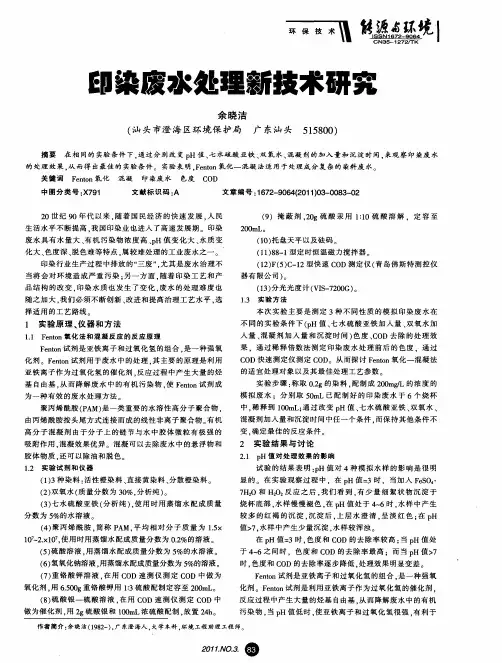
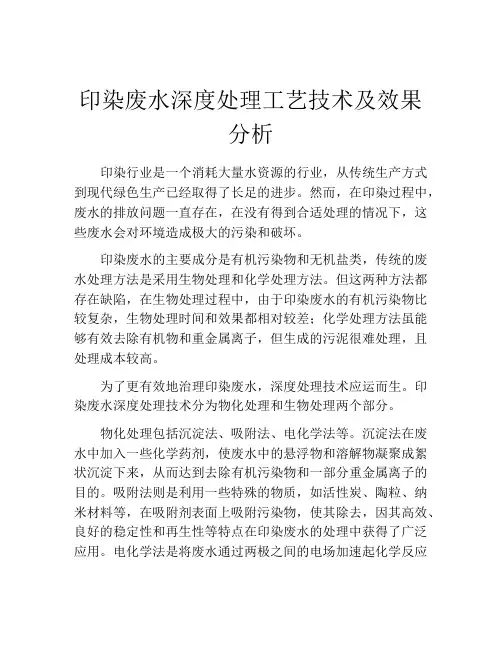
印染废水深度处理工艺技术及效果分析印染行业是一个消耗大量水资源的行业,从传统生产方式到现代绿色生产已经取得了长足的进步。
然而,在印染过程中,废水的排放问题一直存在,在没有得到合适处理的情况下,这些废水会对环境造成极大的污染和破坏。
印染废水的主要成分是有机污染物和无机盐类,传统的废水处理方法是采用生物处理和化学处理方法。
但这两种方法都存在缺陷,在生物处理过程中,由于印染废水的有机污染物比较复杂,生物处理时间和效果都相对较差;化学处理方法虽能够有效去除有机物和重金属离子,但生成的污泥很难处理,且处理成本较高。
为了更有效地治理印染废水,深度处理技术应运而生。
印染废水深度处理技术分为物化处理和生物处理两个部分。
物化处理包括沉淀法、吸附法、电化学法等。
沉淀法在废水中加入一些化学药剂,使废水中的悬浮物和溶解物凝聚成絮状沉淀下来,从而达到去除有机污染物和一部分重金属离子的目的。
吸附法则是利用一些特殊的物质,如活性炭、陶粒、纳米材料等,在吸附剂表面上吸附污染物,使其除去,因其高效、良好的稳定性和再生性等特点在印染废水的处理中获得了广泛应用。
电化学法是将废水通过两极之间的电场加速起化学反应的速率,将染料和化学药物等对废水的有害物质进行彻底降解。
生物处理则是将印染废水中的有机污染物通过微生物的作用,在一定的环境条件下进行生化降解,生成CO2、H2O等较为简单的无害物质。
新型的生物处理技术有外加微电解技术和启动剂技术等,可有效地提高废水降解能力和降解效率。
印染废水深度处理之后,能够达到一定的排放标准,其处理效果要远远好于传统的处理方式。
具体分析如下:1. 印染废水的COD、NH3-N、TP等污染物都能够达到国家排放标准之内,达到了回收再利用的要求。
2. 在处理印染废水的过程中,这些新的深度处理技术减少了处理成本和处理时间,大大提高了处理效率,完全达到了绿色环保的理念。
总之,通过深度处理技术可将有毒有害的印染废水转化成为对环境无害或较小影响的洁净废水,这是印染企业实现绿色生产的必由之路,同时也是保护环境的应有之义。
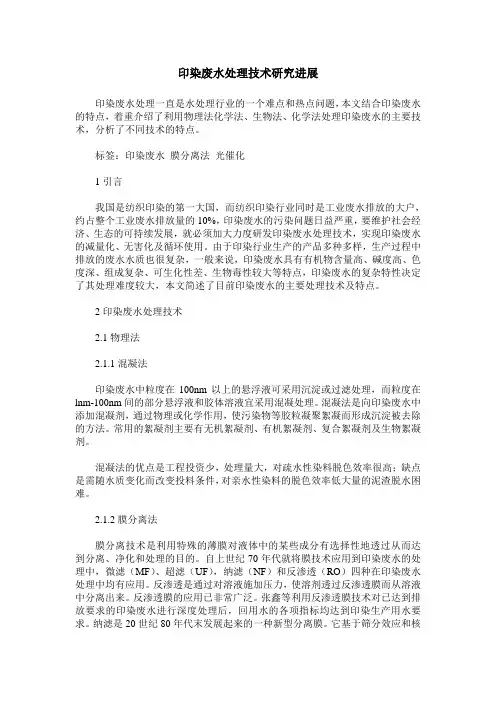
印染废水处理技术研究进展印染废水处理一直是水处理行业的一个难点和热点问题,本文结合印染废水的特点,着重介绍了利用物理法化学法、生物法、化学法处理印染废水的主要技术,分析了不同技术的特点。
标签:印染废水膜分离法光催化1引言我国是纺织印染的第一大国,而纺织印染行业同时是工业废水排放的大户,约占整个工业废水排放量的10%,印染废水的污染问题日益严重,要维护社会经济、生态的可持续发展,就必须加大力度研发印染废水处理技术,实现印染废水的减量化、无害化及循环使用。
由于印染行业生产的产品多种多样,生产过程中排放的废水水质也很复杂,一般来说,印染废水具有有机物含量高、碱度高、色度深、组成复杂、可生化性差、生物毒性较大等特点,印染废水的复杂特性决定了其处理难度较大,本文简述了目前印染废水的主要处理技术及特点。
2印染废水处理技术2.1物理法2.1.1混凝法印染废水中粒度在100nm以上的悬浮液可采用沉淀或过滤处理,而粒度在lnm-100nm间的部分悬浮液和胶体溶液宜采用混凝处理。
混凝法是向印染废水中添加混凝剂,通过物理或化学作用,使污染物等胶粒凝聚絮凝而形成沉淀被去除的方法。
常用的絮凝剂主要有无机絮凝剂、有机絮凝剂、复合絮凝剂及生物絮凝剂。
混凝法的优点是工程投资少,处理量大,对疏水性染料脱色效率很高;缺点是需随水质变化而改变投料条件,对亲水性染料的脱色效率低大量的泥渣脱水困难。
2.1.2膜分离法膜分离技术是利用特殊的薄膜对液体中的某些成分有选择性地透过从而达到分离、净化和处理的目的。
自上世纪70年代就将膜技术应用到印染废水的处理中,微滤(MF)、超滤(UF),纳滤(NF)和反渗透(RO)四种在印染废水处理中均有应用。
反渗透是通过对溶液施加压力,使溶剂透过反渗透膜而从溶液中分离出来。
反渗透膜的应用已非常广泛。
张鑫等利用反渗透膜技术对已达到排放要求的印染废水进行深度处理后,回用水的各项指标均达到印染生产用水要求。
纳滤是20世纪80年代末发展起来的一种新型分离膜。
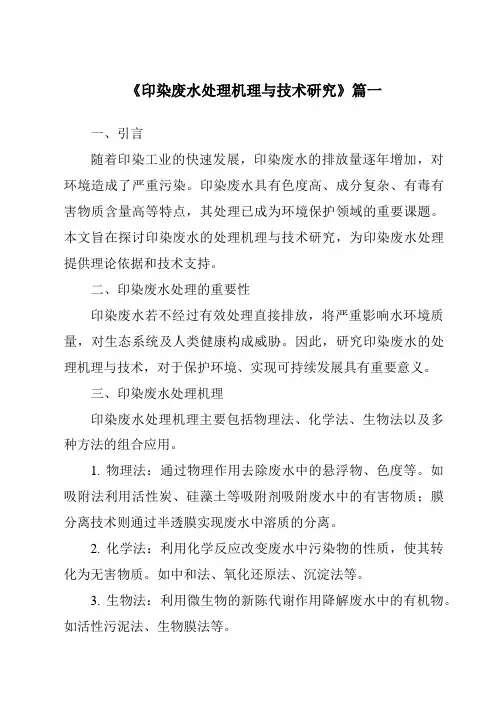
《印染废水处理机理与技术研究》篇一一、引言随着印染工业的快速发展,印染废水的排放量逐年增加,对环境造成了严重污染。
印染废水具有色度高、成分复杂、有毒有害物质含量高等特点,其处理已成为环境保护领域的重要课题。
本文旨在探讨印染废水的处理机理与技术研究,为印染废水处理提供理论依据和技术支持。
二、印染废水处理的重要性印染废水若不经过有效处理直接排放,将严重影响水环境质量,对生态系统及人类健康构成威胁。
因此,研究印染废水的处理机理与技术,对于保护环境、实现可持续发展具有重要意义。
三、印染废水处理机理印染废水处理机理主要包括物理法、化学法、生物法以及多种方法的组合应用。
1. 物理法:通过物理作用去除废水中的悬浮物、色度等。
如吸附法利用活性炭、硅藻土等吸附剂吸附废水中的有害物质;膜分离技术则通过半透膜实现废水中溶质的分离。
2. 化学法:利用化学反应改变废水中污染物的性质,使其转化为无害物质。
如中和法、氧化还原法、沉淀法等。
3. 生物法:利用微生物的新陈代谢作用降解废水中的有机物。
如活性污泥法、生物膜法等。
四、印染废水处理技术研究针对印染废水的特点,研究人员开发了多种处理方法,以下为几种主要技术:1. 生物处理技术:利用微生物的代谢作用降解有机物。
如厌氧生物处理技术、好氧生物处理技术等。
其中,厌氧生物处理技术能够产生生物气,实现资源化利用。
2. 高级氧化技术:利用强氧化剂或光催化等技术将有机物分解为小分子物质。
如光催化氧化法、芬顿试剂法等。
这些技术能够有效地去除废水中的难降解有机物。
3. 膜分离技术:利用半透膜实现废水中溶质的分离。
如超滤、纳滤、反渗透等技术,可有效去除废水中的盐分、重金属等有害物质。
4. 组合技术:根据印染废水的特点,将多种处理方法组合应用。
如“物理法+化学法”、“生物法+高级氧化技术”等。
组合技术能够充分发挥各种技术的优势,提高处理效果。
五、结论印染废水处理是环境保护领域的重要课题,本文详细阐述了印染废水的处理机理与技术研究。
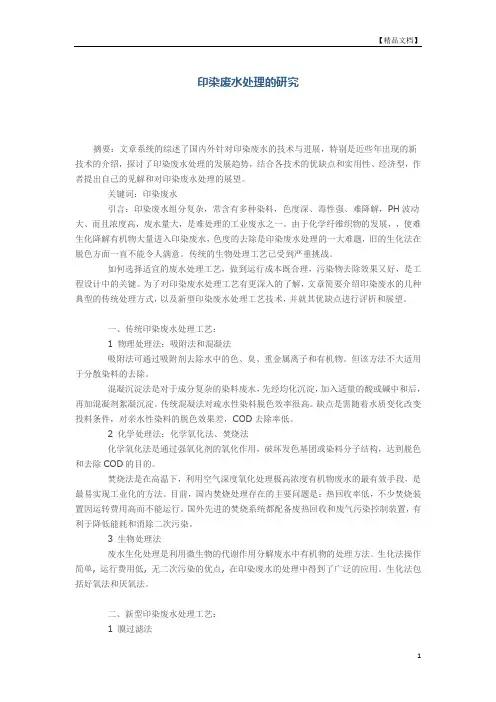
印染废水处理的研究摘要:文章系统的综述了国内外针对印染废水的技术与进展,特别是近些年出现的新技术的介绍,探讨了印染废水处理的发展趋势,结合各技术的优缺点和实用性、经济型,作者提出自己的见解和对印染废水处理的展望。
关键词:印染废水引言:印染废水组分复杂,常含有多种染料,色度深、毒性强、难降解,PH波动大、而且浓度高,废水量大,是难处理的工业废水之一。
由于化学纤维织物的发展,,使难生化降解有机物大量进入印染废水,色度的去除是印染废水处理的一大难题,旧的生化法在脱色方面一直不能令人满意。
传统的生物处理工艺已受到严重挑战。
如何选择适宜的废水处理工艺,做到运行成本既合理,污染物去除效果又好,是工程设计中的关键。
为了对印染废水处理工艺有更深入的了解,文章简要介绍印染废水的几种典型的传统处理方式,以及新型印染废水处理工艺技术,并就其优缺点进行评析和展望。
一、传统印染废水处理工艺:1 物理处理法:吸附法和混凝法吸附法可通过吸附剂去除水中的色、臭、重金属离子和有机物。
但该方法不大适用于分散染料的去除。
混凝沉淀法是对于成分复杂的染料废水,先经均化沉淀,加入适量的酸或碱中和后,再加混凝剂絮凝沉淀。
传统混凝法对疏水性染料脱色效率很高。
缺点是需随着水质变化改变投料条件,对亲水性染料的脱色效果差,COD去除率低。
2 化学处理法:化学氧化法、焚烧法化学氧化法是通过强氧化剂的氧化作用,破坏发色基团或染料分子结构,达到脱色和去除COD的目的。
焚烧法是在高温下,利用空气深度氧化处理极高浓度有机物废水的最有效手段,是最易实现工业化的方法。
目前,国内焚烧处理存在的主要问题是:热回收率低,不少焚烧装置因运转费用高而不能运行。
国外先进的焚烧系统都配备废热回收和废气污染控制装置,有利于降低能耗和消除二次污染。
3 生物处理法废水生化处理是利用微生物的代谢作用分解废水中有机物的处理方法。
生化法操作简单, 运行费用低, 无二次污染的优点, 在印染废水的处理中得到了广泛的应用。
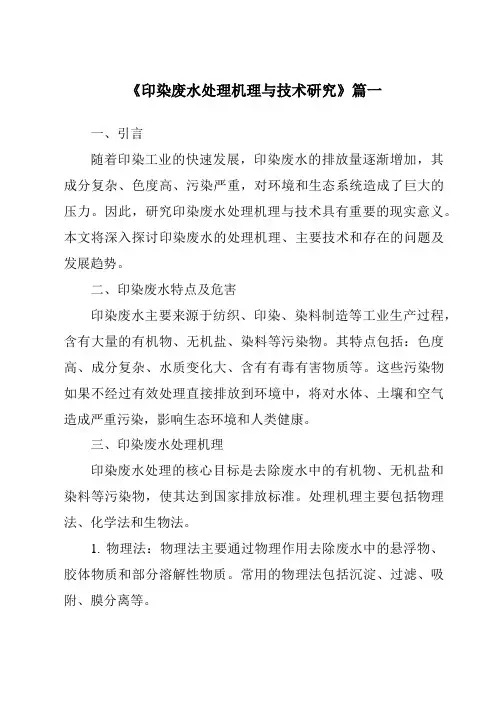
《印染废水处理机理与技术研究》篇一一、引言随着印染工业的快速发展,印染废水的排放量逐渐增加,其成分复杂、色度高、污染严重,对环境和生态系统造成了巨大的压力。
因此,研究印染废水处理机理与技术具有重要的现实意义。
本文将深入探讨印染废水的处理机理、主要技术和存在的问题及发展趋势。
二、印染废水特点及危害印染废水主要来源于纺织、印染、染料制造等工业生产过程,含有大量的有机物、无机盐、染料等污染物。
其特点包括:色度高、成分复杂、水质变化大、含有有毒有害物质等。
这些污染物如果不经过有效处理直接排放到环境中,将对水体、土壤和空气造成严重污染,影响生态环境和人类健康。
三、印染废水处理机理印染废水处理的核心目标是去除废水中的有机物、无机盐和染料等污染物,使其达到国家排放标准。
处理机理主要包括物理法、化学法和生物法。
1. 物理法:物理法主要通过物理作用去除废水中的悬浮物、胶体物质和部分溶解性物质。
常用的物理法包括沉淀、过滤、吸附、膜分离等。
2. 化学法:化学法主要通过化学反应改变污染物的性质,从而将其从废水中分离出来。
常用的化学法包括氧化还原法、混凝沉淀法、中和法等。
3. 生物法:生物法利用微生物的代谢作用将有机物转化为无害物质,具有成本低、效率高等优点。
常用的生物法包括活性污泥法、生物膜法、生物接触氧化法等。
四、印染废水处理技术根据不同的处理机理,印染废水处理技术主要分为以下几种:1. 物理化学法:包括吸附法、混凝沉淀法等。
吸附法利用多孔性固体物质吸附废水中的污染物,如活性炭吸附;混凝沉淀法通过投加混凝剂使废水中的胶体物质发生凝聚沉淀。
2. 生物处理法:包括活性污泥法、生物膜法和生物接触氧化法等。
这些方法利用微生物的代谢作用将有机物转化为无害物质,具有较好的处理效果和较低的成本。
3. 高级氧化技术:如光催化氧化法、臭氧氧化法等。
这些技术利用强氧化剂将有机物分解为低分子量化合物或无机物,具有较高的处理效率和较低的二次污染风险。
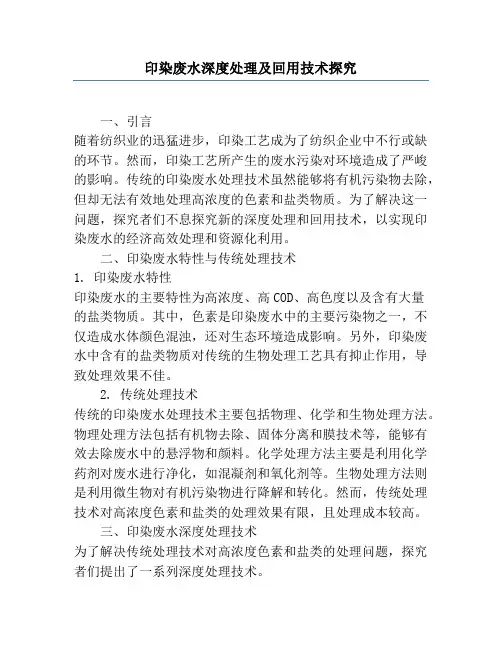
印染废水深度处理及回用技术探究一、引言随着纺织业的迅猛进步,印染工艺成为了纺织企业中不行或缺的环节。
然而,印染工艺所产生的废水污染对环境造成了严峻的影响。
传统的印染废水处理技术虽然能够将有机污染物去除,但却无法有效地处理高浓度的色素和盐类物质。
为了解决这一问题,探究者们不息探究新的深度处理和回用技术,以实现印染废水的经济高效处理和资源化利用。
二、印染废水特性与传统处理技术1. 印染废水特性印染废水的主要特性为高浓度、高COD、高色度以及含有大量的盐类物质。
其中,色素是印染废水中的主要污染物之一,不仅造成水体颜色混浊,还对生态环境造成影响。
另外,印染废水中含有的盐类物质对传统的生物处理工艺具有抑止作用,导致处理效果不佳。
2. 传统处理技术传统的印染废水处理技术主要包括物理、化学和生物处理方法。
物理处理方法包括有机物去除、固体分离和膜技术等,能够有效去除废水中的悬浮物和颜料。
化学处理方法主要是利用化学药剂对废水进行净化,如混凝剂和氧化剂等。
生物处理方法则是利用微生物对有机污染物进行降解和转化。
然而,传统处理技术对高浓度色素和盐类的处理效果有限,且处理成本较高。
三、印染废水深度处理技术为了解决传统处理技术对高浓度色素和盐类的处理问题,探究者们提出了一系列深度处理技术。
1. 高级氧化技术高级氧化技术是利用强氧化剂对废水中的有机污染物进行降解。
常用的高级氧化技术包括臭氧氧化、过氧化氢氧化以及光催化氧化等。
这些技术能够将废水中的有机物转化为二氧化碳和水,达到高效降解的效果。
2. 生物分类技术生物分类技术是在生物处理的基础上,融合了分离与富集技术,通过对微生物的富集分类,实现对印染废水中的有机物的高效降解。
该技术利用了微生物的生理特性,提高了有机物的降解能力。
3. 膜技术膜技术是一种物理处理技术,通过膜的选择性透过性,将废水中的有机物、颜料和盐类物质分离。
常用的膜技术包括微滤、超滤、逆渗透和纳滤等。
膜技术能够高效去除废水中的悬浮物和有机物,同时保留水中的无机盐,实现废水的回用。

印染废水处理技术改进研究印染废水指的是印染工艺中的废水,通常含有高浓度的染料、助剂等有机物质和重金属等污染物质。
这类污染物质的释放对环境造成了严重的影响,因此印染废水处理技术的改进一直是环保领域的重点研究之一。
传统的印染废水处理技术主要采用生化法、物化法和物生化联合法等方法,但存在着很多问题。
例如,生化法需要大量的土地和运营时间,物化法不能有效地降解某些有机物质,物生化联合法难以处理高浓度的印染废水。
因此,近年来,人们对印染废水处理技术进行了深入的研究,提出了许多新的处理方式。
以下是其中的一些例子。
一、电化学氧化法电化学氧化法是一种利用电解技术将废水中的有机物质氧化降解的方法。
相比传统的废水处理技术,电化学氧化法具有反应速度快、降解效率高、无污泥产生等优点。
电化学氧化法还可以用于处理含有重金属的废水,并能够将这些重金属有效地回收利用。
但是,该技术在应用过程中仍面临着成本高、设备复杂等问题。
二、微生物燃料电池微生物燃料电池是利用微生物将废水中的有机物质转化为电流的一种方法。
废水中的有机物质被微生物分解后,释放出电子和质子,并通过电极将电子传输。
微生物燃料电池存在一些特殊的优点,如可以在低温下工作、适用于各种类型的废水、处理效率高等。
但是,该技术在运作时可能会产生一些有害物质,需要进一步优化。
三、活性炭吸附法活性炭吸附法是利用活性炭的物理吸附作用将废水中的有机物质吸附降解的方法。
活性炭有较强的表面化学活性,在与废水接触时,可以迅速吸附有机物质,降低废水中有机物的浓度。
该方法具有简单易行、效果显著等优点。
但是,由于活性炭的稳定性较差,在长期使用过程中会出现吸附能力下降等问题。
以上是目前研究的一些印染废水处理技术,各有优劣,但仍面临着许多挑战和限制。
随着科学技术的进步,相信未来将有更多创新的技术应用于印染废水处理领域,为环境保护做出更大的贡献。
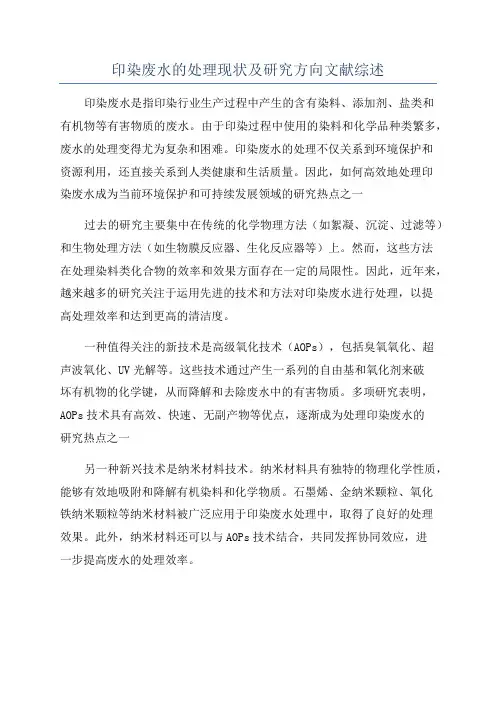
印染废水的处理现状及研究方向文献综述印染废水是指印染行业生产过程中产生的含有染料、添加剂、盐类和有机物等有害物质的废水。
由于印染过程中使用的染料和化学品种类繁多,废水的处理变得尤为复杂和困难。
印染废水的处理不仅关系到环境保护和资源利用,还直接关系到人类健康和生活质量。
因此,如何高效地处理印染废水成为当前环境保护和可持续发展领域的研究热点之一过去的研究主要集中在传统的化学物理方法(如絮凝、沉淀、过滤等)和生物处理方法(如生物膜反应器、生化反应器等)上。
然而,这些方法在处理染料类化合物的效率和效果方面存在一定的局限性。
因此,近年来,越来越多的研究关注于运用先进的技术和方法对印染废水进行处理,以提高处理效率和达到更高的清洁度。
一种值得关注的新技术是高级氧化技术(AOPs),包括臭氧氧化、超声波氧化、UV光解等。
这些技术通过产生一系列的自由基和氧化剂来破坏有机物的化学键,从而降解和去除废水中的有害物质。
多项研究表明,AOPs技术具有高效、快速、无副产物等优点,逐渐成为处理印染废水的研究热点之一另一种新兴技术是纳米材料技术。
纳米材料具有独特的物理化学性质,能够有效地吸附和降解有机染料和化学物质。
石墨烯、金纳米颗粒、氧化铁纳米颗粒等纳米材料被广泛应用于印染废水处理中,取得了良好的处理效果。
此外,纳米材料还可以与AOPs技术结合,共同发挥协同效应,进一步提高废水的处理效率。
此外,一些研究还尝试利用生物技术处理印染废水,如利用微生物和植物对废水中的有害物质进行降解和吸附。
生物吸附、生物降解和植物根系净化等方法在印染废水处理中显示出良好的应用前景。
总的来说,印染废水处理目前依然面临着挑战和难题,但是随着新技术的不断涌现和研究的深入,相信将会有更多高效、环保的处理方法被开发出来。
未来的研究方向可以包括结合多种技术和方法进行综合处理、探索新型纳米材料的应用、开发具有高效生物降解能力的微生物菌种等。
通过不懈的努力和创新,相信印染废水处理技术将不断得到提升,为环境保护和可持续发展做出更大的贡献。
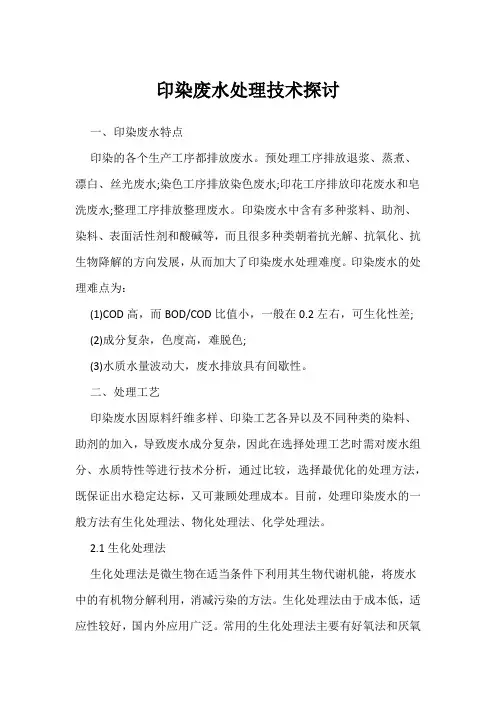
印染废水处理技术探讨一、印染废水特点印染的各个生产工序都排放废水。
预处理工序排放退浆、蒸煮、漂白、丝光废水;染色工序排放染色废水;印花工序排放印花废水和皂洗废水;整理工序排放整理废水。
印染废水中含有多种浆料、助剂、染料、表面活性剂和酸碱等,而且很多种类朝着抗光解、抗氧化、抗生物降解的方向发展,从而加大了印染废水处理难度。
印染废水的处理难点为:(1)COD高,而BOD/COD比值小,一般在0.2左右,可生化性差;(2)成分复杂,色度高,难脱色;(3)水质水量波动大,废水排放具有间歇性。
二、处理工艺印染废水因原料纤维多样、印染工艺各异以及不同种类的染料、助剂的加入,导致废水成分复杂,因此在选择处理工艺时需对废水组分、水质特性等进行技术分析,通过比较,选择最优化的处理方法,既保证出水稳定达标,又可兼顾处理成本。
目前,处理印染废水的一般方法有生化处理法、物化处理法、化学处理法。
2.1生化处理法生化处理法是微生物在适当条件下利用其生物代谢机能,将废水中的有机物分解利用,消减污染的方法。
生化处理法由于成本低,适应性较好,国内外应用广泛。
常用的生化处理法主要有好氧法和厌氧法。
好氧生物处理废水的特点是对BOD去除率高,但对COD和色度去除效果不明显。
厌氧法可降解含有偶氮基、蒽醌基、三苯甲烷基的印染废水,厌氧生物能把难降解的有机物分解成小分子有机物,然后再通过好氧微生物分解成无机小分子物质。
但由于微生物对温度、pH 值、营养物质等条件有要求较高,难以适应印染废水水质波动大、污染物种类多、毒性高等特点,同时生化处理法还存在脱色效果不佳、COD去除率低及管理复杂等缺点,因此生化处理法必须与其它处理方法组合使用,才能确保处理效果。
2.2物化处理法2.2.1吸附法吸附法在物化处理法中应用最多。
用吸附法处理印染废水,是利用吸附剂的多空性、巨大的比表面积或化学键力作用,吸附废水中的一种或几种污染物,达到废水净化的目的。
吸附剂种类多样,包括活性炭、壳聚糖、生物质、活性氧化铝和粉煤灰等。
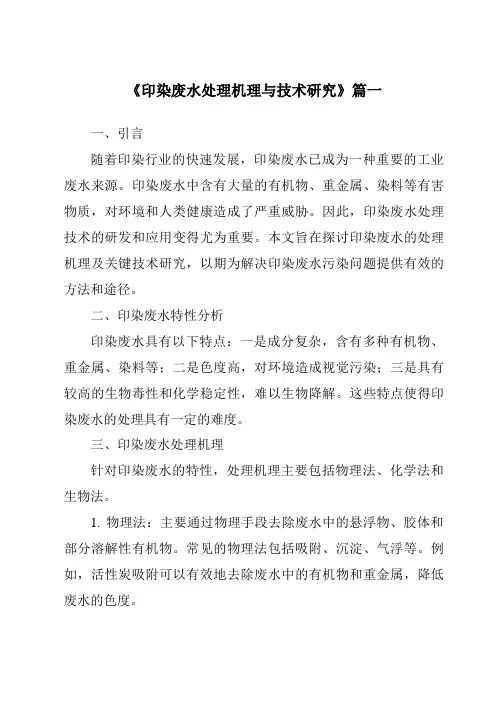
《印染废水处理机理与技术研究》篇一一、引言随着印染行业的快速发展,印染废水已成为一种重要的工业废水来源。
印染废水中含有大量的有机物、重金属、染料等有害物质,对环境和人类健康造成了严重威胁。
因此,印染废水处理技术的研发和应用变得尤为重要。
本文旨在探讨印染废水的处理机理及关键技术研究,以期为解决印染废水污染问题提供有效的方法和途径。
二、印染废水特性分析印染废水具有以下特点:一是成分复杂,含有多种有机物、重金属、染料等;二是色度高,对环境造成视觉污染;三是具有较高的生物毒性和化学稳定性,难以生物降解。
这些特点使得印染废水的处理具有一定的难度。
三、印染废水处理机理针对印染废水的特性,处理机理主要包括物理法、化学法和生物法。
1. 物理法:主要通过物理手段去除废水中的悬浮物、胶体和部分溶解性有机物。
常见的物理法包括吸附、沉淀、气浮等。
例如,活性炭吸附可以有效地去除废水中的有机物和重金属,降低废水的色度。
2. 化学法:利用化学反应改变废水中污染物的性质,从而达到净化水质的目的。
常见的化学法包括氧化还原法、混凝沉淀法等。
例如,利用强氧化剂将有机物分解为无害物质,降低废水的生物毒性。
3. 生物法:利用微生物的代谢作用将有机物转化为无害物质。
生物法主要包括活性污泥法、生物膜法等。
该方法在处理印染废水时,能有效地去除有机物和氮、磷等营养物质。
四、关键技术研究针对印染废水的处理,以下几种关键技术值得关注:1. 高级氧化技术:利用强氧化剂产生羟基自由基等活性物质,将有机物迅速分解为二氧化碳和水等无害物质。
该方法能有效去除印染废水中的有机物和色度,具有较高的处理效率。
2. 膜分离技术:利用半透膜的孔径对分子进行筛选和分离。
该技术可用于印染废水的深度处理,有效去除残留的有机物和重金属,提高出水水质。
3. 生物强化技术:通过投加特定微生物或构建高效生物反应器,提高生物处理的效率和效果。
该技术可针对不同种类的印染废水进行定制化处理,具有较好的应用前景。
工业印染废水处理方法及其原理分析1、引言近年来,随着我国工厂的不断增多,工业废水排放量日益增大,水环境质量不断恶化,水环境保护问题引起人们的广泛关注。
印染废水具有水量大、有机污染物浓度高、色度深碱性大、可生化性较差、水质变化大、成分复杂等特点。
随着国民经济的发展,印染企业发展迅速,其废水问题也越来越严重,如治理不当将会严重污染环境,对人体健康产生较大的影响,因此,要改善工业印染废水问题,需要不断提高印染废水处理工艺水平,并选择合理的处理方法。
鉴于此,本文主要就工业印染废水处理方法及其原理进行了论述。
2、工业印染废水的常用处理方法及原理2.1 物理化学方法2.1.1 混凝法化学混凝法是处理印染废水的常用方法,曾被认为是最有效、最经济的脱色技术之一。
混凝就是在混凝剂的离解和水解产物作用下,使水中的胶体污染物和细微悬浮物脱稳并凝聚为具有可分离性的絮凝体的过程,其中包括凝聚和絮凝两个过程,统称为混凝。
在废水中投加混凝剂可以达到降低或消除ξ电位的目的,从而降低或消除胶粒间的排斥能峰,使胶粒碰撞结合。
影响印染废水混凝效果的因素主要是水温、pH值和染料品种。
印染废水的水温一般比较高,可加速无机盐类混凝剂的水解过程,对混凝过程有利。
pH值可通过人工调节来满足。
混凝法的主要优点是一次性投资较低;操作管理技术要求不高;针对不同水质选用合适的絮凝剂,其处理效果和处理成本均可控制在适当的水平。
缺点为:对于某些废水,可能存在加药量大或絮凝剂昂贵的情况,导致运行成本偏高适用范围窄,对可溶性的有色污染物质脱色效果差;产生大量化学污泥,对污泥的处理和处置进一步增加了运行成本及操作管理的难度,且容易造成二次污染;占地面积较大。
2.1.2 吸附法吸附法是采用吸附剂吸附水中的污染物,可去除色度、悬浮物、胶体及溶解性有机物。
在印染废水处理中所用的吸附剂主要有活性炭、焦炭、硅聚合物、硅藻土、高岭土和工业炉渣等。
不同吸附剂对染料有选择性,影响吸附的条件有温度T、接触时间t和pH值等。
印染废水的处理技术及资源化利用研究一、引言随着纺织工业的发展,印染废水成为了一个不可避免的问题。
印染废水的排放不仅会对环境造成污染,而且还会对人们的生活带来一定的危害。
为了解决这一问题,许多专家学者进行了深入的研究,提出了许多印染废水的处理技术及资源化利用方案。
本文将以此为主题,对印染废水的处理技术及资源化利用进行系统性的探讨。
二、印染废水的特点印染废水的主要特点是含有高浓度的有机物和重金属。
由于不同品种的印染工艺不同,因此印染废水的组成也会有所不同,但是总体来说,印染废水中的有机物主要来自于印染工艺中的染料、助剂和各种化学品。
同时,印染废水的酸碱度也会有所不同。
印染废水中的重金属主要是来自于染料中的其他物质、处理废水的污泥和废物等。
这些重金属在经过印染工艺后,往往会被残留在纤维上,从而形成了印染废水中的重金属成分。
此外,印染废水中也会含有苯、甲苯、二甲苯等有机物,这些有机物在经过氧化处理之后可能会对人体健康造成影响。
因此,印染废水的处理工艺必须考虑到这些特点,制定相应的方案进行处理。
三、印染废水的处理技术1. 生物处理技术生物处理技术是目前比较常用的一种印染废水处理技术。
生物处理技术的原理是通过生物菌群对有机物进行氧化降解,达到废水处理的目的。
在印染废水处理中,生物法的处理效果主要取决于生物菌群的品种、数量和处理系统的构建情况。
生物法的处理过程中,可以采用活性污泥、生物接触氧化池、厌氧/好氧处理等不同的系统构建方式。
2. 物化处理技术物化处理技术是指对有机物和重金属进行物理和化学处理的技术。
这种处理技术主要包括氧化反应、沉淀法、吸附法、电化学法等。
其中,氧化反应法是将废水中的有害物质进行化学反应,使其与氧反应生成更稳定和更容易被过滤的废物。
沉淀法是通过添加一些化学试剂,使废水中的悬浮颗粒物和重金属离子形成不溶于水的沉淀物质,达到净化废水的目的。
吸附法是通过吸附剂将废水中的有机物吸附在表面,然后移除该吸附剂以达到净化废水的目标。
纺织印染废水处理技术研究摘要:文中通过对纺织印染生产工艺及废水的产生进行论述,重点比较分析了几种纺织印染废水处理方法,选择最优化的处理技术。
关键词:纺织印染;废水处理;生产工艺;处理方法纺织工业废水污染物主要是棉毛等纺织纤维上的污物、盐类、油类和脂类,以及各种浆料、染料、表面活性剂、助剂、酸、碱等,纺织工业废水量大,是严重的污染源之一。
纺织工业废水含有大量的有机污染物,排入水体将破坏水生生态平衡,恶化环境。
因此要做好纺织工业废水无害化处理。
1生产工艺及废水的产生1.1生产工艺棉纺织产品主要是由棉花或棉花与化学纤维混合后经过纺纱、染色(或印花)、整理等工序生产出的产品。
有纯棉(白坯布、漂白布、染色布、印花布)产品和棉混织产品(白坯布、漂白布、染色布、印花布)。
棉混纺织产品中化学纤维所占比例较大(一般均超过棉花的数量)。
棉及棉混纺织产品可分为薄型织物(普通白布及染色布)及厚型织物(绒布、灯芯绒布)两种。
根据织造方式的不同,棉及棉混纺织产品可分为机织产品(由经纱和纬纱相互交错而织成的产品)和针织产品(由针将纱线钩成线圈,再将线圈相互串套而成的织物产品),除了染色前处理过程略有不同之外,其染色及印花工艺基本相同。
1.2废水来源棉纺织工业废水主要来自染整工段,包括退浆、煮炼、漂白、丝光、染色、印花和整理等排放较少织造工段废水。
1.2.1退浆废水棉织物上的浆料和纤维本身的部分杂质在漂染前必须去除。
退浆废水一般占废水总量的15%左右,污染物约占总量的一半。
退浆废水是碱性的有机废水,含有各种浆料分解物、纤维屑、酸和酶等污染物,废水呈淡黄色。
退浆废水的污染程度和性质视浆料的种类而异:过去多用天然淀粉浆料,淀粉浆料的BOD5/CODcr值为0.3~0.5;目前使用较多的化学浆料(如PVA)的BOD5/CODcr值为0.1左右;近年来改性淀粉逐渐有取代化学浆料的趋势,改性淀粉的可生化降解性非常好,BOD5/CODcr值为0.5~0.8。
印染废水处理技术探究进展一、引言印染行业是水污染的主要源头之一,长期以来,印染废水对环境造成了严峻的污染和破坏。
印染废水中含有大量的有机染料、助剂、盐类等难降解污染物,不仅对四周水体和土壤造成污染,还恐吓着人类的健康。
因此,在印染废水处理技术方面的探究和应用具有重要意义。
二、传统的印染废水处理技术1. 化学法化学法是最常用的处理印染废水的方法之一,包括氧化法、还原法、沉淀法等。
其中,氧化法通过添加氧化剂来使有机染料氧化分解,还原法则是通过添加还原剂使有机物发生还原反应。
沉淀法则利用沉淀剂将废水中的悬浮物和沉淀性污染物沉淀下来。
然而,这些传统化学法处理废水存在着一些问题,如副产物产生、处理成本高等。
2. 生物法生物法指利用微生物或植物来处理废水的方法,包括好氧法、厌氧法、人工湿地等。
好氧法通过添加氧气使微生物氧化有机物为无机物,而厌氧法则是在无氧条件下使微生物还原和乳酸发酵。
人工湿地则是通过植物根系和微生物共同作用来降解有机物。
生物法处理废水的优点是处理效果好,副产物较少,但有些有机染料难以被微生物分解降解。
三、新型的印染废水处理技术1. 高级氧化技术高级氧化技术是近年来进步起来的一种处理废水的新技术,包括光催化氧化、臭氧氧化等。
光催化氧化是一种利用半导体材料(如二氧化钛)吸纳紫外光产生电子空穴对来氧化分解有机污染物的技术。
臭氧氧化则是通过臭氧的强氧化性将有机物降解成无害的物质。
高级氧化技术具有降解效果好、副产物较少的优点,但设备成本较高。
2. 膜分离技术膜分离技术是利用不同孔径的膜来将有机物、盐类、重金属等进行分离的一种技术,包括超滤、逆渗透等。
超滤是利用孔径在10-20nm范围的过滤膜将溶解于水中的高分子有机物进行分离。
逆渗透则是利用孔径在0.1-1nm范围的膜来除去废水中的盐类和重金属。
膜分离技术具有操作简便、处理效果好的优点,但在印染废水处理中的应用还面临着一些挑战,如膜的污染和膜的选择性。
印染废水脱色处理技术的研究印染废水脱色处理技术的研究随着印染行业的迅猛发展,印染废水已成为环境污染的主要来源之一。
印染废水中含有大量有机染料和助剂,对环境造成了严重的污染和健康风险。
因此,研究印染废水脱色处理技术具有重要意义。
印染废水的主要特征是有机染料浓度高、色度高、COD (化学需氧量)高、pH值偏酸或偏碱等。
传统的处理方法如沉淀、氧化、生物降解等存在诸多问题,如处理时间长、副产物产生多、消耗能源等。
因此,需要寻找一种高效、经济、环保的脱色处理技术。
目前,一些新型的脱色处理技术正在被研究和应用。
其中之一是活性炭吸附技术。
活性炭对有机染料具有很强的吸附能力,能够有效去除废水中的有机染料。
但是,活性炭使用过程中容易饱和,需要经常更换或再生,增加了成本。
另一个研究热点是光催化技术。
光催化技术通过光照激发催化剂的活性,将有机染料降解为低分子化合物或无害物质。
常用的催化剂包括二氧化钛、二氧化硅等。
光催化技术具有处理效果好、操作简便、无二次污染等优点,但目前还存在光催化剂的选择、光照强度控制等问题。
另外,一些新型的生物技术也有望应用于印染废水脱色处理。
例如,固定化微生物技术可以将高效的染料降解菌固定在反应器中,提高菌体的利用率和稳定性。
此外,一些基因工程技术也能够通过改变菌体的代谢途径,使其具有更好的降解能力。
此外,还有一些结合技术也值得探索。
例如,将活性炭和光催化技术结合使用,可以提高废水中有机染料的去除率和处理效果。
另外,也可以利用氧化法预处理废水,将有机染料氧化为易于生物降解的中间产物,再采用生物降解技术进行最终的处理。
印染废水脱色技术的研究还面临一些挑战。
首先,不同的染料种类和配方对应不同的处理方法,需要进行个性化的处理。
其次,废水处理过程中产生的废弃物和副产物如何处理也是一个问题。
应该优先考虑尽量减少副产物的产生,或者找到合理的利用途径。
综上所述,印染废水脱色处理技术的研究是解决印染行业环境污染的重要途径。
印染废水处理机理与技术研究印染废水处理机理与技术研究摘要:印染工业是一种以染料和助剂为主要原料的大气污染行业,其废水的处理成为了环境保护的重点之一。
本文探讨了印染废水处理的机理与技术,并对印染废水的特性、传统处理工艺以及新型处理技术进行了分析和综述。
通过研究可以发现,传统的生化处理方法虽然能够有效去除废水中的有机物和颜料,但对低浓度难降解染料无法达到理想的处理效果。
而新型的物理化学方法和膜技术在印染废水处理方面具有更好的应用前景。
关键词:印染废水处理,机理,技术研究,有机物,颜料 1. 引言印染工业是一种常见的纺织工艺,其废水中含有丰富的有机物和颜料,这使得印染废水处理成为了环境保护的重点之一。
有效处理印染废水,不仅能够减少对环境的污染,还可以实现资源的回收和再利用。
因此,研究印染废水处理的机理与技术对于解决环境问题具有重要意义。
2. 印染废水特性分析印染废水的特性主要表现在以下几个方面:2.1 高浓度有机物印染工业使用大量的染料和助剂,其中许多是有机物质,导致印染废水中有机物浓度较高。
2.2 多样性的染料印染工艺中使用的染料种类繁多,染料结构复杂,具有不同的降解性能和毒性特性。
2.3 易溶解性和难降解性某些染料在水中具有良好的溶解性,而且在自然环境中降解速度较慢,难以通过传统的处理方法进行有效去除。
3. 传统处理工艺目前,印染废水处理主要采用物理、化学和生物的方法,常用的处理工艺包括沉淀、吸附、生化处理等。
3.1 沉淀沉淀是通过添加化学药剂使废水中的悬浮颗粒和溶解物聚集形成较大的颗粒,从而实现固液分离。
但该方法只能去除一部分颜料和有机物,不能达到完全去除的效果。
3.2 吸附吸附是指利用吸附剂将废水中的有机物和颜料吸附在其表面,从而达到去除的目的。
常用的吸附材料有活性炭、陶瓷颗粒等。
吸附方法可以较好地去除有机物,但对于某些难降解的染料仍然不够理想。
3.3 生化处理生化处理是将废水中的有机物通过微生物的代谢作用转化为无机物。
常用的生化处理方法包括曝气活性污泥法、接触氧化法等。
生化处理方法可以有效地去除有机物和颜料,但对于一些低浓度和难降解的染料处理效果不佳。
4. 新型处理技术针对传统处理方法存在的问题,一些新型处理技术被提出和研究应用,包括物理化学方法和膜技术。
4.1 光催化氧化法光催化氧化法利用紫外光激发半导体光催化剂产生带隙的电子和空穴,通过氧化反应降解废水中的有机物和染料。
该方法具有高效、无二次污染等优点,已被广泛应用于印染废水处理。
4.2 高级氧化技术高级氧化技术包括臭氧氧化、过氧化氢氧化、超声波氧化等,可通过产生强氧化剂来降解废水中的有机物和染料。
4.3 膜技术膜技术包括超滤、反渗透等,可以通过膜的筛选和分离作用实现对废水中的有机物、染料和溶解盐的处理与回收。
5. 结论印染废水处理是一项复杂而重要的任务。
传统的处理工艺可以去除部分有机物和颜料,但对于特定的染料和难降解有机物的处理效果不佳。
新型的物理化学方法和膜技术为印染废水的处理提供了更好的解决方案。
未来的研究应进一步优化和完善新技术,并结合实际工程应用,以满足印染废水处理的需求,实现绿色、可持续发展。
Title: Advanced Techniques for the Treatment of Dyeing and Printing WastewaterIntroduction:Dyeing and printing wastewater is a complex mixture of organic compounds and dyes, which pose a significant threat to both the environment and human health. Traditional treatment methods are limited in their effectiveness towards reducing the concentration of organic compounds and colorants in low concentrations and those that are difficult to degrade. Thus, there is a need for advanced techniques to address these issues. This article explores the potential of photodegradation, advanced oxidation processes, and membrane technologies as novel approaches for thetreatment of dyeing and printing wastewater.1. Photocatalytic Oxidation:Photocatalytic oxidation utilizes semiconductor photocatalysts excited by ultraviolet light to generate electrons and holes, which participate in oxidation reactions to degrade organic compounds and dyes present in wastewater. This technique offers several advantages, such as high efficiency and minimal secondary pollution, making it a widely explored method for dyeing and printing wastewater treatment.2. Advanced Oxidation Processes:Advanced oxidation processes encompass various techniques including ozone oxidation, hydrogen peroxide oxidation, and ultrasound oxidation. These methods generate powerful oxidizing agents to degrade organic compounds and dyes in wastewater. Ozone oxidation involves the use of ozone gas to oxidize pollutants, while hydrogen peroxide oxidation employs the use of hydrogen peroxide as an oxidizing agent. Ultrasound oxidation utilizes high-frequency sound waves to generate free radicals for the degradation of pollutants. These techniques have shown promising results in the treatment of dyeing and printing wastewater.3. Membrane Technologies:Membrane technologies, such as ultrafiltration andreverse osmosis, have gained increasing attention in recent years for their ability to selectively separate and remove organic compounds, dyes, and dissolvedsalts from wastewater. Ultrafiltration membranes work based on size exclusion, while reverse osmosis membranes operate on the principle of pressure-driven separation. These membrane technologies offer a sustainable approach for the treatment and recovery of valuable resources from dyeing and printing wastewater. Conclusion:In conclusion, the treatment of dyeing and printing wastewater is a complex and critical task. While traditional treatment processes can remove someorganic compounds and colorants, they are often ineffective against specific dyes and difficult-to-degrade organic pollutants. Advanced techniques suchas photocatalytic oxidation, advanced oxidation processes, and membrane technologies provide better solutions for the treatment of dyeing and printing wastewater. Further research should focus onoptimizing and refining these new technologies, integrating them into practical engineering applications, to meet the demands of sustainable and green dyeing and printing wastewater treatment在染料和印染废水处理方面,传统的处理方法往往对特定染料和难降解的有机污染物效果较差。
而光催化氧化、先进氧化工艺和膜技术等先进技术为染料和印染废水处理提供了更好的解决方案。